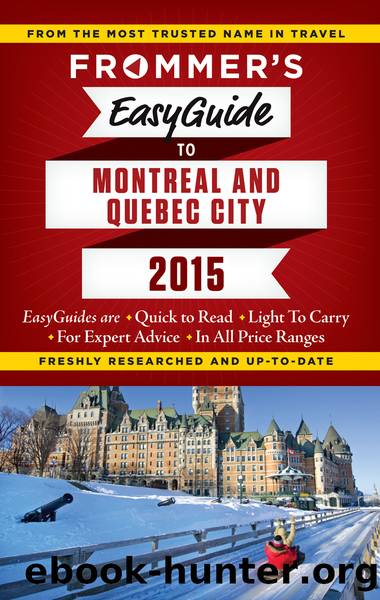Frommer's EasyGuide to Montreal and Quebec City 2015 by Erin Trahan

Author:Erin Trahan
Language: eng
Format: epub
Publisher: FrommerMedia
Published: 2015-08-14T16:00:00+00:00
Finish:
Musée des Beaux-Arts and the lively rue Crescent
Time:
2 hours
Best Times:
Weekdays in the morning or after 2pm, when the streets hum with big-city vibrancy but aren’t too busy.
Worst Times:
Weekdays from noon to 2pm, when the streets are crowded with businesspeople on lunch-break errands; Monday, when museums are closed; and Sunday, when many stores are closed and much of downtown is nearly deserted.
After a tour of Vieux-Montréal, a look around the commercial heart of the 21st-century city will highlight the ample contrast between these two areas. To see the city at its contemporary best, take the Métro to the Bonaventure stop to start this tour.
After you’ve emerged from the Métro station, the dramatic skyscraper immediately to the west (or directly above you, depending on which exit you take) is:
1 1000 rue de la Gauchetière
Also called “Le 1000,” this contribution to downtown Montréal is easily identified along the skyline by its copper-and-blue pyramidal top, which rises to the maximum height permitted by the municipal building code. Although it’s mostly offices inside, it also has a year-round indoor skating rink (p. 94) under a glass dome.
Walk west on rue de la Gauchetière. Ahead is Le Marriott Château Champlain, whose distinctive facade of half-moon windows inspired its nickname “the Cheese Grater.” Turn right on rue de la Cathedrale, heading north. At the next corner, you reach:
2 Boulevard René-Lévesque
Formerly Dorchester Boulevard, this street was renamed in 1988 following the death of René Lévesque, the Parti Québécois leader who led the movement for Québec independence and the province’s use of the French language. Boulevard René-Lévesque is the city’s broadest downtown thoroughfare.
Across bd. René-Lévesque is:
3 Square Dorchester
This is one of downtown’s central locations. It’s a gathering point for tour buses and horse-drawn calèches, and the square’s shade trees and benches invite lunchtime brown-baggers. This used to be called Dominion Square, but it was renamed for Baron Dorchester, an early English governor, when the adjacent street, once named for Dorchester, was changed to boulevard René-Lévesque. The square was built over an old cemetery for 1832 cholera epidemic victims. Along the square’s east side is the Sun Life Insurance building, built in three stages between 1914 and 1931, and the tallest building in Québec from 1931 until the skyscraper boom of the post–World War II era.
At the north end of the square is:
4 Montréal's Central Tourist Office
The Infotouriste Centre at 1255 rue Peel has maps and brochures and bilingual attendants, who are eager to answer questions, point you in the right direction, or give advice about hotels or tours. It’s open daily (p. 212).
On bd. René-Lévesque at the corner of Square Dorchester is the:
5 Basilique-Cathédrale Marie-Reine-du-Monde
Suddenly get the feeling you’re in Rome? This cathedral is a copy of St. Peter’s Basilica, albeit a fraction of the size. It was built as the headquarters for Montréal’s Roman Catholic bishop. The statue in front is of Bishop Ignace Bourget, the force behind the project. Construction lasted from 1875 to 1894, its start delayed by the bishop’s desire to place it not in Francophone east Montréal, but in the heart of the Protestant Anglophone west.
Download
This site does not store any files on its server. We only index and link to content provided by other sites. Please contact the content providers to delete copyright contents if any and email us, we'll remove relevant links or contents immediately.
Lonely Planet's Ultimate Travel by Lonely Planet(544)
Florida by Lonely Planet(484)
Lonely Planet Berlin (Travel Guide) by Lonely Planet & Andrea Schulte-Peevers(298)
The wines of Canada by Rod Phillips(265)
Lonely Planet Canada (Travel Guide) by Lonely Planet(238)
Moon Pacific Northwest by Allison Williams(220)
Frommer's EasyGuide to Montreal and Quebec City 2015 by Erin Trahan(215)
Fodor's Montreal & Quebec City by Fodor's Travel Guides(176)
Moon Best of Glacier, Banff & Jasper by Andrew Hempstead(175)
Fodor's Montreal & Quebec City 2015 by Fodor's Travel Guides(162)
